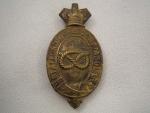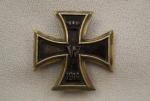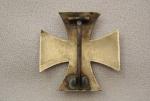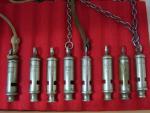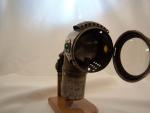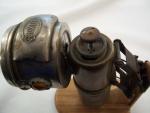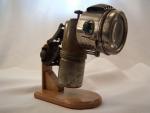-
Posts
6,486 -
Joined
-
Last visited
-
Days Won
10
Content Type
Profiles
Forums
Blogs
Gallery
Events
Store
Everything posted by Brian Wolfe
-
There comes a time in your collecting life that you start to fill in those gaps left as you have built your collection over the years. Admittedly the numbers of gaps I have to fill will indeed take up the rest of my life...I'm not complaining, mind. One of the items that have managed to elude me for several years has finely found a home in my Staffordshire collection. This horse martingale badge is from the Victorian period (for pictures of the Elizabeth II martingale see post #123 in this section). I believe I have covered the history of the martingale in that previous post so this is one of those “look what I got” posts. I will admit that I am more than a little pleased to be adding this horse badge to the collection. Regards Brian
-

rust on museum sword blade
Brian Wolfe replied to peter monahan's topic in Preservation & Restoration of Military Artifacts
Well done Peter, I'm happy to hear that this worked out. Your remark regarding the employment of museum people by municipalities is much more accurate than the public can even imagine. Most of them know enough to impress the village idiots who get elected and only enough about conservaton to be dangerous to the artifacts. On top of all of this these types end up hiring their own friends to work as guides and assistants. Regards Brian -
I've wanted a small artillery piece for years with the intention of making a gun emplacement in our small bush lot in the back of the property. Something with sand bags etc. to look like a hidden gun emplacement. I've recently been told that Linda will tollerate almost any of my "odd" ideas regarding collecting but a cannon of any size, shape or type will be the final straw. I mention this as you are not the only one who comes up with ideas that seem to bewilder our wives and perhaps drives them over the edge. Good luck my friend, just remember that in marridge, if you are going to dance on the mine field you will have to get used to being called "stumpy". Regards Brian
-

Iconic Firearms - what do you think?
Brian Wolfe replied to Brian Wolfe's topic in Firearms & Ordnance
Smokin' nice Tommy. (yes, pun intended). Regards Brian -

France Bruce Willis made Commander of the Order of Arts and Letters
Brian Wolfe replied to JPL's topic in France
This from a country who thinks Jerry Lewis is a comedic genius, so why not. Regards Brian -

WWII four place medal bar
Brian Wolfe replied to turtle's topic in Great Britain: Orders, Gallantry, Campaign Medals
Or Canadian but as you say probably British. REgards Brian -

Uncategorised Your favourite Combat worn cross
Brian Wolfe replied to Chris Boonzaier's topic in Germany: All Eras: The Iron Cross
-
Here is my small police whistle collection. From left to right: Buck’s Special Constabulary A.R.P. with badge Essex Constabulary Clarke Leicester Metropolitan Police London 1942 City Police or Fire Whistle, C.T.W’S G.P.O. (Post Office) Kent Special Constabulary Liverpool City Police Staffordshire Constabulary The last, an unmarked specimen, belonged to a good friend of mine and a former Police Constable “H” Division who served from 1967 to 1974, City of London, Bethnal Police Station (London’s East End). He was a Home Beat or Community Officer. It’s not often you get a whistle with as much information. The former PC’s name is withheld to preserve his privacy. Regards Brian
-
Hello Fellows, This is a great post and one I've wanted to get involved with for some time now, thank you for starting it off. My offering in the military is a set of Second World War whistles from 1939 through to 1945. The whistle to the far right, I have been told, is to the Royal Navy, WWII. From what I have read, and I stand to be corrected, the Royal Navy never had their whistles dated and used the doubled neck chain. I have one lonely First World War whistle dated 1915. I would like to finish the WWI group some day. Regards Brian
-

ww11 scramble bell
Brian Wolfe replied to blueman's topic in Great Britain: Militaria: Badges, Uniforms & Equipment
Very nice blueman, what I could do that early in the morning when the kids won't get up. Regards Brian -
The last photo of this series on the calcium carbonate lamp shows the mounting clamp. The spring sections probably helped to limit vibrations experienced through the frame of the bicycle from the rough road surface. You will notice that the lamp, when mounted, naturally leans somewhat downwards and I would think this was to better direct the light on the road ahead. I like to display my specimens and since this style of lamp will not stand upright on its own I made the small stand to better show it off as it would have been mounted on the bicycle. Regards Brian
-
These photos show the burner where the acetylene flame was produced and the light chamber with the reflector at the back. This particular reflector is cracked but still in place. In the photo you can see that the whole light chamber comes off easily for either cleaning, repair or perhaps for lighting the burner. When lighting a calcium cabonate lamp the flame, at first, sputters and needs time to "settle down" after which the water drip rate can be adjusted for the amount of light needed. I would suspect that this was done with the light chamber off, then once the flame is under control, replaced. I say this because of the ease at which this section is removed and replaced.
-
Carbide Bicycle Lamp There was a need for officers to make use of the bicycle in their patrols, especially in the rural areas. I believe Mervyn may have touched on this in his earlier fictional work about the life of a constable in the early years of policing in England. Naturally the officer would be required to use a bicycle after sunset and therefore required a light for the same reasons we would need one today. The lamp I am featuring in this installment is actually a French Luxor Carbide Bicycle Lamp, from around 1910 to perhaps1930. This lamp is one of my favorite specimens in the collection as it involved more than simply pouring in a fuel and lighting the wick. These lamps required a chemical reaction in order to produce the fuel. What fascinates me is that the chemical reaction was all within the lamp and not in a manufacturing plant then shipped to a vendor for sale to the lamp user. It required the user to actually mix together two materials to generate the fuel. My old chemistry teacher would be so proud, and not a little surprised, if he could know that I am writing anything about a chemical reaction. When I look back I cannot but feel a bit sympathetic for this fellow who persistently remarked that he knew, as his student, I was capable of turning out much better work, and yet I, just as persistently, disproved his hypnotises over and over. The carbide lamp required the user to place calcium carbonate in the bottom portion of the lamp and water in a reservoir located above the calcium carbonate container. The water could be regulated to drip at a controlled rate onto the calcium carbonate below and thereby produce acetylene gas. This gas was then ignited and a light producing flame was the result. By filling the bottom container with calcium carbonate from ½ to ¾ full one could have light for one to two hours. Once the calcium carbonate was used up a white sludge was left which was dumped out and, if needed, the whole process was started over. I am going to digress from the topic for a moment with a personal opinion. When you think about the process set out above, the user actually created a flammable gas in a miniature manufacturing plant, being the lamp itself. It would seem to me that people back a century or more ago were closer to the actual process required to produce a required result than young people of today. For those with even a spark of intellect there must have been a stimulation of the thought process lacking in today’s “flip a switch and you are rewarded” world. Through studies and surveys it has been found that an alarming percentage of today’s population have no idea where or how electricity is produced or where the waste goes after they flush the toilet. We seem to be witnessing a generation of lab rats or at least Pavlov’s dogs. I could not resist sharing that thought with you, it’s just an observation. I’ve read one author’s opinion, somewhere, that these lights served more to indicate the location of the bike rider rather than actually producing sufficient light. I found that a strange comment as I have seen videos where these lamps were show lit and a good deal of light was produced. In fact this type of lamp system was and still is used by people who are engaged in caving. I have read that today the lead person in a cave expedition often uses a calcium carbide lamp as the light has a wider spread than an electrical light while producing a strong beam. I understand the soot produced by the acetylene lamp can be used to mark the cave wall with a dark patch in which may be written, with a finger, directional marks etc. The soot is an eco-friendly medium and will not disturb the cave environment. I hope you find this lamp as interesting and as fascinating as I do. Regards Brian
-
Sorry it has taken so long to respond but I wanted to research your question before confessing failure. So far I have found nothing. This post has been "pinned" and will remain at the top of the section until I have conpleted it so I hope one of the members with this knowledge will see your question and be able to assist you. Regards Brian
-
Hello dug, CHM = Company Havildar Major (Company Sargeant Major). When it comes to post 1947 Indian medals almost anything is possible, in other words the regualtions may be set down but when it comes time for the medals to be named the regs. go out the window and anything goes. It is very frustrating for collectors and those interested in Independent India's Military history. The rank is a good one however, so well done on this addition to your collection. Regards Brian
-
Hello dug, Welcome and good to see a new member interested in the medals of India, I wish I could help you but this remains a puzzle. I'm sorry to say that Mr. Haynes left the forum a number of years ago so we cannot tap into his knowledge base. If I find anything out I will post it here, I hope you will do the same. Regards Brian
-

Iconic Firearms - what do you think?
Brian Wolfe replied to Brian Wolfe's topic in Firearms & Ordnance
I have moved this post from the Lounge to here with the hope more of our members with an interest in firearms will see it. Remember iconic firearms can also include those items you have always liked but not necessarily own yourself. Regards Brian -

Iconic Firearms - what do you think?
Brian Wolfe replied to Brian Wolfe's topic in Firearms & Ordnance
Excellent video, many thanks for posting it. The weapon fired was a Model 1853 Three Band rifle musket, I believe. Not that it matters as the priciple is the same. One point (a personal opinion) is that the weapon should only be at half cock when the percussion cap is placed on the nipple. To carry out this action at full cock, as in the demonstration, is inviting an accidental discharge, as these were not equiped with a safety device, except for the half cock position. I just checked my own M1853 and the half cock position allows the precussion cap to be installed with no problems, in case anyone was wondering. A soldier would then raise the musket to his shoulder while engaging the hammer to the full cock position and fire the weapon. One would not want to blow the sergeant's head off "accidently" by carrying out this proceedure at full cock. Regards Brian



